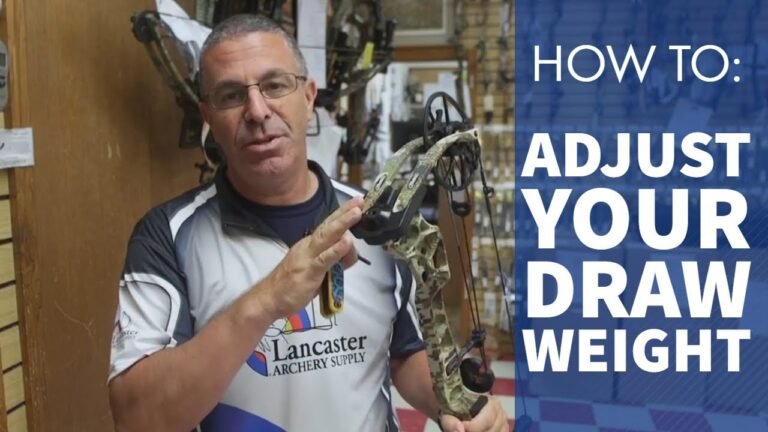Mastering the Art of Adjusting Draw Weight on a Compound Bow

If you're looking to fine-tune your compound bow for optimal performance, learning how to adjust draw weight is crucial. Finding the best method to do this can be a game-changer for your archery experience. In this article, we'll explore the top techniques and tips for adjusting draw weight on your compound bow, so you can hit the bullseye every time. Whether you're a beginner or a seasoned pro, mastering this skill will undoubtedly elevate your bowhunting or target shooting game.
How does adjusting draw weight impact accuracy?
Adjusting draw weight can have a significant impact on accuracy, as it directly affects the power and speed of the arrow. When choosing the right draw weight for your bow, it's crucial to consider your strength and experience level to ensure the best accuracy. Starting with a draw weight that is appropriate for your abilities will help you achieve the most accurate and consistent shots.
What factors should I consider when choosing a compound bow draw weight?
When choosing a compound bow draw weight, it's important to consider your own strength and endurance. A good rule of thumb is to select a draw weight that requires about 75% of your maximum strength. This will allow you to comfortably draw back the bow and shoot multiple times without getting fatigued. If the draw weight is too heavy, it can lead to reluctance to practice and hinder your improvement in archery.
Selecting the right draw weight for your compound bow is crucial for your performance and enjoyment in archery. It's recommended to choose a draw weight that allows you to comfortably shoot multiple times without getting fatigued. If the draw weight is too heavy, it can hinder your progress and make you less likely to practice. Finding the balance between a draw weight that challenges you and one that allows you to shoot comfortably will greatly impact your game.
What is the appropriate amount to increase my draw weight by?
If you're considering increasing your draw weight, it's important to do so gradually and with careful consideration. A good rule of thumb is to increase your draw weight by no more than 2-3 pounds at a time. This allows your muscles to gradually adapt and build strength without risking injury.
Additionally, it's important to listen to your body and pay attention to any signs of fatigue or strain. If you're feeling overly fatigued or experiencing pain while drawing your bow, it's a sign that you may have increased your draw weight too quickly. In this case, it's best to decrease your draw weight and give your muscles time to recover before attempting to increase it again.
Remember, the goal of increasing your draw weight is to improve your shooting and overall performance. By taking a gradual and mindful approach, you can safely and effectively increase your draw weight while minimizing the risk of injury.
Fine-Tuning Your Draw Weight for Precision
Fine-tuning your draw weight is essential for achieving precision in your shooting. By adjusting the draw weight of your bow, you can ensure that you have the right amount of force behind each shot, leading to more accurate and consistent results. Whether you are a beginner or a seasoned archer, taking the time to fine-tune your draw weight can make a significant difference in your overall performance. Experiment with different draw weights to find the perfect balance for your individual shooting style, and watch as your precision improves with each shot.
Achieving Perfect Draw Weight Balance
Achieving perfect draw weight balance is essential for an optimal archery experience. By carefully adjusting the tension of your bow, you can ensure that you are able to draw the string smoothly and consistently, leading to more accurate and powerful shots. Finding the right balance will not only improve your accuracy, but also reduce the risk of injury and fatigue, making it easier to maintain proper form throughout your shooting session. Whether you are a beginner or a seasoned archer, taking the time to fine-tune your draw weight balance will undoubtedly enhance your overall performance on the range or in the field.
Mastering Precision with Adjusted Draw Weight
Looking to take your archery game to the next level? Mastering precision with adjusted draw weight is the key to hitting your target with unparalleled accuracy. By carefully fine-tuning the draw weight of your bow, you can achieve a level of control and consistency that will elevate your performance to new heights. Whether you are a seasoned competitor or a casual enthusiast, mastering precision with adjusted draw weight will give you the edge you need to outperform the competition and take your archery skills to the next level.
Adjusting the draw weight of your bow is a crucial step in mastering precision and control. With the right draw weight, you can achieve a smooth and steady release, resulting in tighter groupings and more accurate shots. By honing in on the ideal draw weight for your individual strength and shooting style, you can unleash your full potential and become a force to be reckoned with on the archery range. So, if you're ready to take your skills to the next level, mastering precision with adjusted draw weight is the key to unlocking your true archery prowess.
In conclusion, adjusting the draw weight on a compound bow is crucial for achieving optimal performance and accuracy. By following the step-by-step guide outlined in this article, you can easily customize the draw weight to your preference and improve your overall shooting experience. Remember to always consult a professional if you are unsure about making adjustments, and practice proper safety measures at all times. With the best how to adjust draw weight on compound bow techniques at your disposal, you can enhance your archery skills and enjoy a more precise and enjoyable shooting experience.
